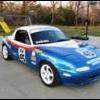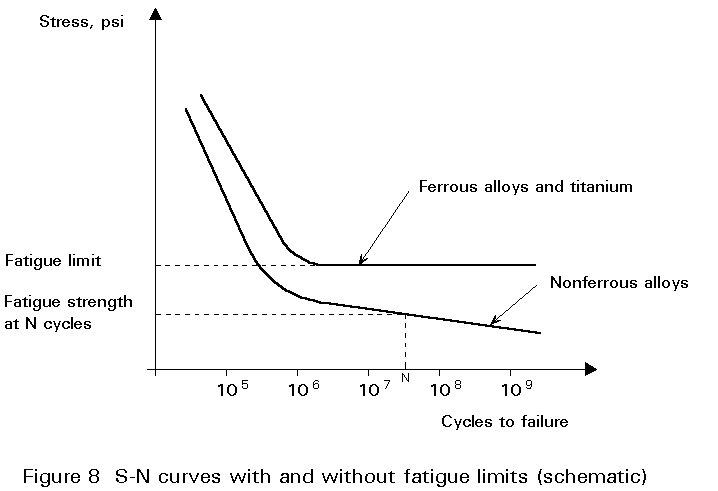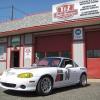
Spring life
#1

 Posted 01-20-2018 08:09 PM
Posted 01-20-2018 08:09 PM

Had the same springs on my car since 2008 and just wondering if there is a way I can test mine to see if they are still good.


#2

 Posted 01-21-2018 02:49 AM
Posted 01-21-2018 02:49 AM

Base information from Eibach, video at 36 seconds, "spring constant". Who has a spring tester??? http://eibach.com/us/p-18-quality.html
Knowledge: http://ijer.in/ijer/...R_2015_1013.pdf
- B(Kuch)Kucera45 likes this



#3

 Posted 01-21-2018 07:52 AM
Posted 01-21-2018 07:52 AM

We have always tested our springs, partly because in the past I had heard disparaging remarks about Eibachs, but we have found consistency to be good and minimal if any change in those we retested after a season or more of use.
Obviously our tests are just the simplest ones of overall length, and the spring rate using a shop press with one of our race scales. If you do this preload the spring, say a couple hundred pounds, then zero the scale and begin the test.
- B(Kuch)Kucera45 likes this


#4

 Posted 01-21-2018 06:48 PM
Posted 01-21-2018 06:48 PM



#5

 Posted 01-21-2018 07:49 PM
Posted 01-21-2018 07:49 PM

I would think the bottom bushing smooshing down would be the likely culprit in lost ride height.
#6

 Posted 01-21-2018 09:59 PM
Posted 01-21-2018 09:59 PM



#7

 Posted 01-22-2018 04:52 AM
Posted 01-22-2018 04:52 AM

And even tho Eibach has a million mile warranty on other vehicle springs, they have zero warranty on their springs used in racing vehicles.



#8

 Posted 01-22-2018 10:15 AM
Posted 01-22-2018 10:15 AM

What I learned many years ago on street cars is that springs do not loose their strength. The loose their height. That is why you see so many 70's and 80's GM cars with a droopy butt.
My experience with any brand of race spring is that they loose a small amount of height after a weekends use. In our cars it is generally about 1/4". My initial allignment with new springs is set a little high. Then come back to the scales after a weekend and set what you want. Very slight if any change after that.
I have a digital spring rate checker if anyone wants to send me springs.
Dave
- lillyweld likes this
Dave Wheeler
Advanced Autosports, the nations most complete Spec Miata shop
Author, Spec Miata Constructors Guide, version 1 and 2.0
Building Championship winning cars since 1995
4 time Central Division Spec Miata Champion car builder 2012-2013-2014-2017
Back to Back June Sprints Spec Miata 1-2 finishes 2016 and 2017
5 time June Sprints winner in Mazda's
6 Time Northern Conference Champion Car Builder
2014 SCCA Majors National point Champion car builder
2014 SCCA Runoffs winner, T4 (Bender)
2014 Central Division Champion, ITS (Wheeler)
2013 Thunderhill 25 hour winning crew chief
2007 June Sprints winner, (GT1, Mohrhauser)
Over 200 race wins and counting.
www.advanced-autosports.com
dave@advanced-autosports.com
608-313-1230





#9

 Posted 01-22-2018 10:29 AM
Posted 01-22-2018 10:29 AM

Been running the same springs since 2012 when we built our car. I've never personally felt them "fall off" in any regard, then again if they did it would be a very gradual process. Would be curious to test old and new springs back to back, if you can get the set up the exact same after swapping.
#10

 Posted 01-22-2018 10:53 AM
Posted 01-22-2018 10:53 AM

Been running the same springs since 2012 when we built our car. I've never personally felt them "fall off" in any regard, then again if they did it would be a very gradual process. Would be curious to test old and new springs back to back, if you can get the set up the exact same after swapping.
Save yourself the trouble, there is effectively zero chance of being able to detect a difference that isn’t obvious from a visual examination or at most a crude bench test. Put your efforts and seat time into something more fruitful. Check your shocks, they are probably at least 10,000 times more likely to develop issues.
- Jim Drago likes this


#11

 Posted 01-22-2018 10:18 PM
Posted 01-22-2018 10:18 PM

Suspension springs really don't see enough stress cycles to have any input into the high cycle fatigue strength.
Steel, especially spring steel alloys have whats called a fatigue strength knee.
This means that if a spring only see's ~40% of its yield stress, for example, it can theoretically last for infinite number of cycles. But if it sees ~70% it can only last 100 million cycles, and ~80% 10 million cycles, 90% 1 million cycles, ect...
when you graph it it looks like this: (you can see the knee where the fatigue limit goes horizontal)

one of the main objectives of spring designers is to design the spring so that even at the spring block height, the steel is only strained to ~40% of its yield strain. meaning that the spring can last for billions of cycles. They can do this by changing the helical angle of the spring, and the thickness of the material that makes up the coil.
I calculated it once and it would take something like 600 years of racing every weekend to get to a billion cycles on your suspension springs. A valve spring or fuel injector return spring might be a different story!
notice how other materials like aluminum and magnesium will always degrade, even after the knee.
What dave is talking about is call spring creep. This is due to prolonged compression and doesn't really affect the springs strength much. Once technology got better and better spring alloys were developed, creep is almost a thing of the past in spring steel.
#engineer
source: http://fgg-web.fgg.u.../wg12/l0200.htm
-Z
- Justin Casey and Steve Scheifler like this
#12

 Posted 01-23-2018 10:52 AM
Posted 01-23-2018 10:52 AM

Even valve springs rarely break by them selves. What happens when you hear some one say they "dropped a valve" in NASCAR land, it is generally valve spring that broke. High lift cams and high RPM require strong valve springs. Usually they are double or triple springs. A spring inside a spring inside a spring. What actually happens is the inner spring rubs on the outer spring. They eventually get hot enough to weld themselves together. Next time the valve opens the spring breaks and the valve DROPS and hits the piston. Currently a oil spray bar is installed inside the valve cover to virtually flood the springs in oil. Back in the 80's and 90's, we used a coating process. The springs where coated with a form of Teflon to act as lubricant to prevent the micro-welding. The Teflon was actually a pink color. I know this because the Trans-Am team I used to run was owned by the guy that did the process. Originally called Flour-plate, a surface impingement process. He did milinons of them for all the Nascar teams.
Dave
- pitbull113 and luvin_the_rings like this
Dave Wheeler
Advanced Autosports, the nations most complete Spec Miata shop
Author, Spec Miata Constructors Guide, version 1 and 2.0
Building Championship winning cars since 1995
4 time Central Division Spec Miata Champion car builder 2012-2013-2014-2017
Back to Back June Sprints Spec Miata 1-2 finishes 2016 and 2017
5 time June Sprints winner in Mazda's
6 Time Northern Conference Champion Car Builder
2014 SCCA Majors National point Champion car builder
2014 SCCA Runoffs winner, T4 (Bender)
2014 Central Division Champion, ITS (Wheeler)
2013 Thunderhill 25 hour winning crew chief
2007 June Sprints winner, (GT1, Mohrhauser)
Over 200 race wins and counting.
www.advanced-autosports.com
dave@advanced-autosports.com
608-313-1230





#13

 Posted 01-23-2018 10:08 PM
Posted 01-23-2018 10:08 PM

Typical hi-tech NASCAR, my Datsun 510s have had oil spray bars since the early ‘70s.


#14

 Posted 01-23-2018 10:21 PM
Posted 01-23-2018 10:21 PM

All you need is a Harbor Freight press, a Longacre wheel scale, and a tape measure, to have a "spring tester" ... right?
Add me to the "Eibachs sucks" camp, at least when it comes to their "street" products ...
- luvin_the_rings likes this
For faster reply than PM: miataboxes>>>AT<<<gmail>>DOT<<<com
#15

 Posted 01-23-2018 10:36 PM
Posted 01-23-2018 10:36 PM

Suspension springs really don't see enough stress cycles to have any input into the high cycle fatigue strength.
Steel, especially spring steel alloys have whats called a fatigue strength knee.
This means that if a spring only see's ~40% of its yield stress, for example, it can theoretically last for infinite number of cycles. But if it sees ~70% it can only last 100 million cycles, and ~80% 10 million cycles, 90% 1 million cycles, ect...
when you graph it it looks like this: (you can see the knee where the fatigue limit goes horizontal)
one of the main objectives of spring designers is to design the spring so that even at the spring block height, the steel is only strained to ~40% of its yield strain. meaning that the spring can last for billions of cycles. They can do this by changing the helical angle of the spring, and the thickness of the material that makes up the coil.
I calculated it once and it would take something like 600 years of racing every weekend to get to a billion cycles on your suspension springs. A valve spring or fuel injector return spring might be a different story!
notice how other materials like aluminum and magnesium will always degrade, even after the knee.
What dave is talking about is call spring creep. This is due to prolonged compression and doesn't really affect the springs strength much. Once technology got better and better spring alloys were developed, creep is almost a thing of the past in spring steel.
#engineer
source: http://fgg-web.fgg.u.../wg12/l0200.htm
-Z
As a (an?) #engineer_times_two myself, what would your #explanation be for SM Eibachs that #relax (measure at lower free height, and lower load at ride height) from initial installation versus after they are run some # (<=not a hashtag) of hours.
#kidding .... #sort_of .... #![]()
- luvin_the_rings likes this
For faster reply than PM: miataboxes>>>AT<<<gmail>>DOT<<<com
#16

 Posted 01-23-2018 10:56 PM
Posted 01-23-2018 10:56 PM

All you need is a Harbor Freight press, a Longacre wheel scale, and a tape measure, to have a "spring tester" ... right?
Add me to the "Eibachs sucks" camp, at least when it comes to their "street" products ...
To the first, exactly, but as I mentioned above start the rate test with the spring compessed a bit then zero the scale.
To the second point, their propaganda makes me think they got that message years ago, but I don’t know if their response went beyond the marketing department.


#17

 Posted 01-24-2018 05:41 AM
Posted 01-24-2018 05:41 AM

#18

 Posted 01-24-2018 09:35 PM
Posted 01-24-2018 09:35 PM

A little pop-corn and
I've read recently that corn in all forms isn't healthy. Full of Lectins and causes inflammation, stay away. The liquid in that glass however looks like Guiness. Nothing wrong with that.
Our cars are oversprung so a slight weakening of the springs might be a feature.




#19

 Posted 01-24-2018 10:06 PM
Posted 01-24-2018 10:06 PM

#20

 Posted 01-26-2018 02:21 PM
Posted 01-26-2018 02:21 PM

Steve,
Great question. I have not witnessed the mentioned #relaxing first person, however I don't doubt it one second.
After forming the springs into the coil shape and flat grinding the ends, the springs typically go through an annealing process to relax the micro cracks in the grain boundaries of the steel that are caused during coiling the straight round bar into a helix. If I had to guess, I'd say that the heat put into the flat ground ends changes the state of heat treatment in that area. When the ground ends go into the annealing process with the rest of the spring, the state of annealing is also different around the ground ends. I imagine (blatant guess) that the manufacturer has to find a sweet spot between durability of the center section of the spring, and the annealed ends, and therefore tolerates some elevated creep tendencies.
Also, don't forget that rubber has a much higher creep constant than steel, especially when heated, so the rubber bushings in the a-arms and spring perch could creep a bit, and change the ride height.
In terms of the spring rate actually changing, I highly doubt this is happening (although it wouldn't be the first time I'm wrong) since the spring rate of a coil spring is only dependent on the geometry of the coil, and the elastic modulus of the material. Creep does not affect the modulus of steel, so as long as the spring diameters and material diameters don't change the spring rate will also stay constant, and therefore the spring load at static condition doesn't change either, it is just shorter distance from end to end of the spring. When the springs weld together like Dave said, this will create stress concentrations and will crack immediately.
more coffee!
-Z
1 user(s) are reading this topic
0 members, 1 guests, 0 anonymous users




 Sign In
Sign In Create Account
Create Account



 Back to top
Back to top Report
Report







